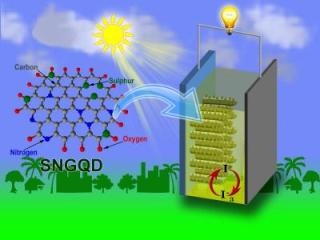Jan 31 2019
Scientists from the National Institute of Technology, India, have synthesized blue-green-orange photo-emissive sulfur and nitrogen co-doped graphene quantum dots (SNGQDs) using hydrothermal technique.
 Graphene quantum dots sensitized C-ZnO nanotaper photoanodes for solar cells application. (Image credit: Authors)
Graphene quantum dots sensitized C-ZnO nanotaper photoanodes for solar cells application. (Image credit: Authors)
These GQDs displayed robust UV-visible photoabsorption and excitation-dependent photoemission, which find application in economical, eco-friendly solar cells. Details of the research can be read in a paper to be published in the upcoming edition of NANO.
Graphene quantum dots (GQDs) have progressed as a new kind of zero-dimensional (0D) carbon-based nanomaterial, comprising of 2–10 monolayer graphene with a size of ~30 nm. These QDs have exclusive electronics and optical properties and have been applied in a broad range of applications such as photoelectrochemical (PEC), photodetector, photocatalysis, solar cells, bioimaging, light emitting diode (LED), metal ions detection, and electroluminescence devices. More notably, the optical absorption and emission of GQDs can be tweaked in wide spectral range (400–700 nm) by just doping a number of elements like S, B, N, F, and so on.
A team of scientists from the Department of Physics and Department of Electronics and Communication Engineering of the National Institute of Technology, India, have enhanced the PEC properties of taper-like ZnO nanorod photoanodes by both C doping and sensitization with S, N co-doped GQDs (SNGQDs). ZnO nanotapers (ZnO NTs) and SNGQDs were synthesized by an economical hydrothermal process. SNGQDs sensitized ZnO NTs photoanodes have been examined in quantum dot sensitized solar cells (QDSSC).
For DSSC fabrication, SNGQDs decorated C-ZnO nanotaper (SNGQD/C-ZnO NTs) photoanodes were employed as working electrodes, and Pt nanoparticle coated FTO was used as counter electrode. The two electrodes were sealed using hot melt plastic spacers (25-m thick, Solaronix) and iodine-based electrolyte (Iodolyte Z-50, Solaronix) was poured in between the electrodes.
Atomic force microscopy (AFM) images of SNGQDs were stored in tapping mode with a Bruker Nanoscope-8 Microscope. Scanning electron microscopy study (SEM) of ZnO nanotapers were performed using a ZEISS SUPRA 40 electron microscope. Transmission electron microscopy (TEM) studies of SNGQDs and ZnO nanotapers were carried out using a JEOL JEM-2100F electron microscope. A PerkinElmer Lambda 950 spectrometer was used to measure the UV-visible absorption spectra in the wavelength range of 200–800 nm. Room temperature photoluminescence (PL) measurements were performed under different excitation wavelengths (340–560 nm) with a PerkinElmer LS 55 fluorescence spectrometer. The chemical composition and bonding of SNGQDs and C-doped ZnO NTs were investigated by an X-ray photoelectron spectrometer (XPS) (PHI 5000 Versa Probe II). The current-voltage characteristics (J–V) of the solar cell devices were measured with the aid of a source meter (B2912A, Agilent, USA) under the illumination of a 100 mW/cm2 light (AM 1.5) from a solar simulator (Enlitech, Taiwan).
The as-grown SNGQDs comprised of one to four monolayers of graphene with an average diameter of 4–25 nm. The chemical bonding and presence of S and N in GQD network were verified through XPS measurements. UV-visible spectrum of SNGQDs revealed four absorption peaks at 261, 341, 469, and 552 nm. These peaks are credited to the electronic transitions from η→η* in sp2 C=C, η→η* in C=O, η→η* in C=N, and η→η* in C=S bonds, respectively. SNGQDs are very luminescent and displayed excitation-dependent photoemission in visible spectrum.
The PEC activities of ZnO nanostructured-based photoanodes were enhanced by linking the SNGQDs with C-doped ZnO nanotapers. SNGQD-sensitized C-ZnO NTs showed greater photoconversion efficiency (n ~ 1.46%) and incident-photon-to-current conversion efficiency (IPCE ~ 92.48% at 340 nm) compared to undoped ZnO NTs and C-ZnO NTs. The photovoltaic performances of such SNGQD-sensitized photoanodes were successfully observed in QDSSC applications. The standard QDSSC device demonstrated JSC ~ 3.04 mA/cm2, VOC ~ 0.45 V, and power-conversion efficiency np ~ 0.59%, which has been enhanced considerably compared to other ZnO-based photoanodes. This current study proved the potential use of SNGQD-decorated C-ZnO NTs photoanodes for economical, eco-friendly QDSSC application.
This research was sponsored by CSIR Extramural Research Grant, Sanction No. 03 (1316)/14/EMR-II, Government of India.
Source: https://www.worldscientific.com